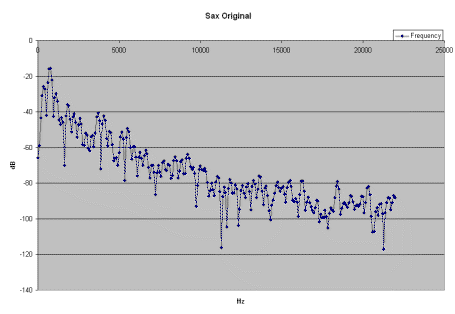
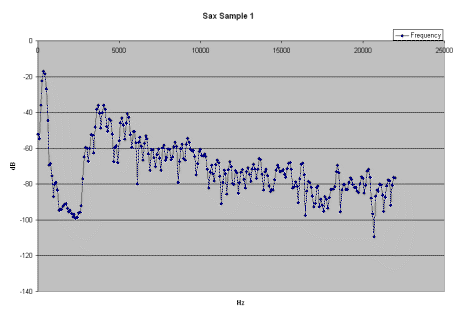

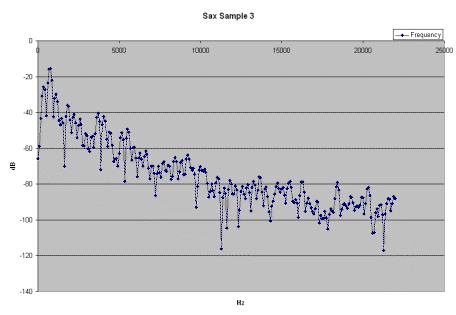
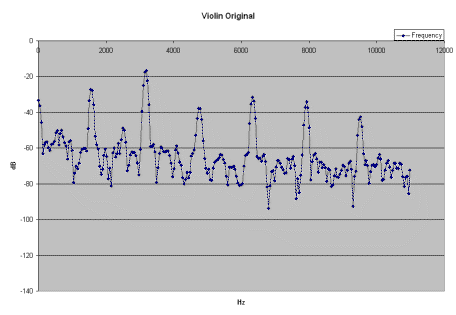

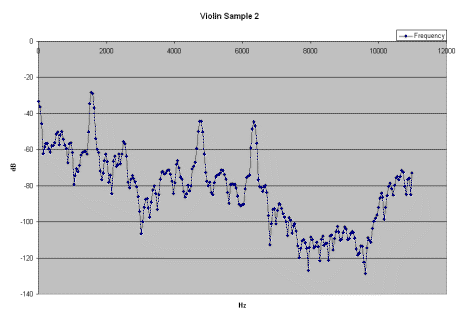
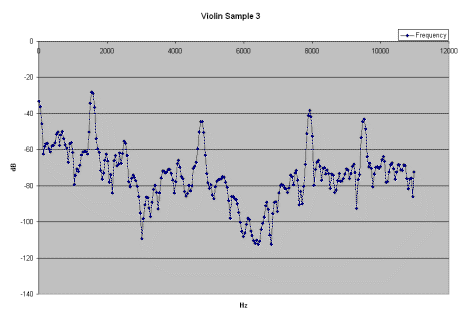
The Affect of Harmonic Frequencies on Sound Color
Project for Physics of Sound 2005 J-Term Final Project
Project done by: Stuart Ness
Originally Completed: January 26, 2005
Table of Contents
Section 1 : Abstract
Section 2
Introduction
Experiment One: Harmonic Intensity Adjustment Changes the
Color of the Sound
Experiment Two: Creating Different Sounds
Sound and Color Relations
Section 3 : Complications in the Data
Section 4 : Conclusion
Section 5 : Acknowledgements
Section 6 : Experiment Information
Section 7 : Graphs and Data
Section 8 : Cited References
Abstract
This paper takes a look at the relation between sound color and harmonic frequencies. Tone color is a subjective part of sound. However, if a large group of singers or instrumentalists is asked to sing or play blue notes or sing or play with a gray quality, the musicians all have the same idea of how to manipulate the instrument to produce a note that gives that certain color quality. In studying the affect of frequencies on test subjects other factors were also taken into account, such as number of harmonics produced by the instrument keeping the volume of the test tones at the same level.
Recently I was told by a graduate in violin performance from the Hart School of Music, that it was suggested to him that when starting to attempt to identify note pitches he should take a box of sixty-four crayons, go to a piano and for each note played on the piano, find a color in the box that best describes that note. The idea is that each note is unique and can be associated with a color. The idea behind this project comes from an understanding that sound is similar to light as both are just a sensory organ picking up the frequency of a wave. In light we talk about colors as a mixture of certain frequencies together to create greens, blues, browns, grays, shades of red, and so forth. If we make an assumption that due to the similar natures of light and sound, it is very easy to create a similar type of qualifier for different combinations of sound. To experiment with this idea, three instruments were used, playing notes at different frequencies. The three instruments were: a fagot organ pipe, a saxophone, and a violin. Once the three instruments were recorded, a wave form editor was used to modify the intensity of the harmonics of each recording to simulate a musician adjusting the tonal color of the instrument. All instruments, depending upon how they are played, have the ability to change the intensity of certain harmonic levels for each note. Tonal color is affected by many aspects, such as tempo, intensity of sound, the frequency intensity of the harmonics, as well as the number of harmonics produced. In experimenting with a number of subjects, it is obvious that people do not agree what sounds contain more or less color, however, they did give many common results to what gives tonal color to a sound. Through the use of two experiments, it is obvious that intensity of certain harmonics of a note play a crucial portion of what adds color to a note.
Experiment One: Harmonic Intensity Adjustment Changes the Color of the Sound
Adjusting the levels of the harmonic frequencies of a sound will change how a certain noise sounds. However, the interpretation of each sound into its color will vary from person to person. What was interesting though is that in the average of the three sounds among the people questioned, in all instruments except the violin, the more frequencies removed from the sound, the less color in the sound. This suggests that each harmonic adds in another color into the sound, to give it greater color. The violin appears to be different due to the power of the second harmonic. The intensity of the second harmonic in the violin is so much greater than all other harmonics by removing it; a great deal of the color is removed from the tone.
Attached in the section labeled experiment one there are three sets of three graphs. These are the frequency spectrums of the test tones used as well as the original test tone which was not played during the experiment. The fagot pipe had the 1000Hz to 2000Hz range for the first sample sound. This first tone was judged to be the most colorful of the three sounds. The second sample sound for the fagot pipe had the 500Hz to 1000Hz range removed as well as the 2000Hz range to 3000Hz range removed. As both of these sounds still had the highest intensity frequency still active the additional range removal made the second tone slightly less colorful than the first. However, the third sound had the greatest intensity harmonic removed as well as the most harmonics removed. Not surprising this sound was selected as the least colorful of the three sounds.
The second instrument tested was the Saxophone. The first and second sounds were viewed as being equally colorful. The first sample sound had the 1000Hz to 3000Hz range removed. The second sound had the 3000Hz to 6000Hz range removed. Many of the participants, however, had a tough time discerning which of these two sound samples had more color. This could possibly be explained by the first sample removing the more intense harmonics, but a 1000Hz range less than the second sample sound. This would make these two sounds equivalent in color. The third sample sound was clearly the picked to be the most colorful of all three sounds. This third sample was the actual sax sound, unaltered. Due to having all harmonics in tact this was viewed as the most colorful.
The third instrument tested was the violin. Initially the results of the violin was a surprise, as the previous test tones had dealt mainly with the 1000Hz to 6000Hz range; the hypothesis was that there was less color in the sound when the 4000Hz to 6000Hz range was removed, as the previous instruments were showing. However with the violin this was not the case. The first sound sample for the violin had the 4000Hz to 10000Hz range removed. Under the previous assumption that the 4000Hz to 6000Hz range influenced color the most, as well as having the most number of harmonics removed this sound should have been heard as the sound with the least amount of color in it. However, the next sound was selected as the least colorful. This sound had the 7000Hz to 10000Hz range removed and the 2600Hz to 4000Hz range. It was this second range removal that was the most intriguing. This sound had both the range immediately above and below the “critical range,” yet it was the sound with the least color. Closer analysis of this then suggested another concept. The intensity of the harmonic at 3014Hz was by far the strongest harmonic, having a close to a 13dB gain above all other harmonics. In the previous sound samples the strongest harmonic had been left in tact. However in this sample the strong harmonic had been removed. That along with the number of harmonics missing created this sound sample to lose the most color. The third sound sample also had this strong harmonic removed and was clearly less colorful than the first sound sample. In addition to the 3014Hz harmonic being removed, the 5000Hz to 7000Hz range had also been removed. This was a considerably smaller range than the second sample, giving more color to the sound.
From this experiment it appears that a great deal of the color of a sound deals with the intensity of certain harmonics. This would suggest that with certain combinations of harmonics certain harmonics are naturally stronger to give a more colorful sound. The idea of intensity led to the development of the second experiment.
Experiment Two: Creating Different Sounds
The second experiment involved a singer singing the same musical phrase while thinking of different colors. The spectrum analysis from this experiment is in the section labeled experiment two. The singer was asked to sing a short passage while thinking of the colors grey, yellow, red, and brown. Under the idea that the intensity of harmonics will affect the sound color, the intensity levels of the harmonics should all be different for the same passage even when same at a constant loudness level.
In the graph section for experiment two there are five spectrum analyses, one for each of the sounds and one with all of the sounds combined. As it is rather difficult to compare the colors on the different sheets the combined sheet is the easiest to look at. From a first glance at the sheet the resonance frequencies are all the same and all included. However, in looking closer at the data, it becomes clear that the highest peaked resonances come from the red and brown colors. The color to take the lowest resonance peaks turns out to be the grey, and the yellow is very similar but slightly higher on the dB scale. This proves to be very interesting when compared with the properties of color and light. Most colors that are seen with the eye are simply a mixture of multiple frequencies of light. If we mix a higher intensity of certain frequencies we get stronger colors. The sound also gives different colors based on the intensity levels of the frequencies. While every person has a different idea of sound and would have a different intensity scaling for every color, it would be expected to see a similar ratio or order of strong to weak frequencies in a color scale. The reason for this is that of the four colors picked, two of the colors, Yellow and Gray (light gray) are more reflecting colors. Red and brown tend to absorb more light. Since our eyes see the intensity levels of these colors, the absorbing colors would take more intensity to reproduce, therefore giving stronger resonance frequencies as a general rule, where as reflecting colors would tend to have smaller peaks on the resonance curves. This experiment did not have a great deal of testing however, as it was a reactionary experiment to the first. However more tests are planned to continue the exploration of this idea with other singers to see if they have similar frequency analyses when singing a passage while thinking of different colors.
In again looking at the spectrum analysis, we see however that at different harmonic frequencies the level of intensity is not evenly adjusted. There are places where the red color has greater intensity than the Brown notes; however, in the 5000Hz to 5500Hz range the Brown notes have the greatest amplitude in comparisons to the other colors. This suggests that the color also tends to focus on certain bands of sound more than others in order to create a certain color in the mind of the singer.
Aside from the experiments, there is a great deal of data on sound and color relationships in theories of music therapy. The relation between color and sound has been suggested many times before. Isaac Newton assigned certain colors to certain notes. Generally “C” tends to be viewed as red. However, beyond that most theories tend to disagree how to continue assigning the colors. Some theorists argue that a scale should be created to correspond the wave lengths with those of the chromatic scale, while others used strange devices to change the music into color.1 Pat Gary, a student that researched the reasons why sounds sound the way they do, suggests that the color of a sound is influenced by the number of harmonics that the sound has. 2
At this point there is not enough evidence that there is a direct relationship between a sound and a color. Due to the number of discrepancies between researchers, it appears to be a psychological relationship rather than a scientific relationship. However the theories that relate wavelength of light to sound as multiples, and then account for higher and lower notes out of the base range as shades and tints of those colors does have interesting concepts, however, it has yet to be proven that the human senses detect sound and light in the same manner.
Unfortunately the subject of color has a great deal of complications in testing. First, the experiments were not done in a room that has suggestions of darker and blander colors. Other complications include a relatively small test group of ten people. Other problems include the perception of color by multiple people is different. Defining exactly what is desired for responses is difficult due to the need for descriptions that are concise and an inability to match people’s descriptions.
Although the intent of this paper is not to discuss whether there is a scientific relationship between light and color, it is very difficult to discuss an idea such as color without wondering if the idea of a color is both true for sound as it is for light. There is a definite relationship between the harmonic frequencies of a note and the colors that are thought of in the mind. Things such as the existence of certain harmonics, the number of harmonics that a sound has makes a big difference in the color of a sound. However, it also appears that a harmonic of great intensity, at least 10dB to 15 dB greater than any other harmonic also causes a greater color to be imagined by a listener.
The research that has been completed at this point still is in a very trial state. In order to effectively evaluate the relation between harmonics, harmonic intensity and color, more tests need to be done using a wider range of harmonic intensities, as well as doing more to test the affect of the number of harmonics on the color of sound. It also would be beneficial to experiment with multiple musicians to understand what affect certain color ideas have on the production of sound as well. Other research should be completed with identification of color to certain instruments notes using a selection from sixty-four crayons to determine the relation of each color to a frequency.
I would like to thank Brent Ness for his assistance in his suggestions for how to approach the experiment data. I would also like to thank those that assisted in the two experiments that I conducted and giving their time and patience to listening to the different sounds being played.
To create the sounds for experiment one; sounds were collected from http://www.findsounds.com using a minimum of 16-bit resolution. These sounds were then imported into Cool Edit Pro by Syntrillium Software. The sound files were then analyzed using the frequency analysis portion of the program and then exported into an Excel spreadsheet to create the graphs to model the frequency analysis. After measuring the resonance frequencies I then used Cool Edit Pro to remove certain frequency areas to change the sound for the sound samples. The samples were all normalized to be roughly the same volume as to not let amplification of any sample to affect the color of the sound samples. I also used a small frequency analyzing program called Auto Tuner written by Terry McGee, which allowed for real-time frequency analysis.
The second experiment was conducted using a Sony voice recorder which was recorded in 32-bit quality and transferred digitally to the computer to be evaluated in Cool Edit Pro and Excel. No modification to the waveforms was done in this second experiment, only the analysis tools of Cool Edit Pro were used.
Experiment One Data
| Frequency Spectrum of a Saxophone |
 |
| Frequency Spectrum of Sax Sample Tone 1 |
 |
| Frequency Spectrum of Sax Sample Tone 2 |
 |
| Frequency Spectrum of Sax Sample 3 |
 |
| Frequency Spectrum of Violin |
 |
| Frequency Spectrum of Violin Sample 1 |
 |
| Frequency Spectrum of Violin Sample 2 |
 |
| Frequency Spectrum of Violin Sample 3 |
 |
Experiment Two Data
| Harmonic sound frequencies of singer singing the same passage while thinking of four different colors. |
 |
1 Lee BK. A Comparitive study of Light and Sound. c1994 [cited 2005 Jan 26]. Available from: http://re-action.com/dc/design/color.html
2 Gary P. Why do sounds Sound the Way They Do? [cited 2005 Jan 26]. Available from: http://faculty.smu.edu/ttunks/projects/gary/OUTLINE.HTM